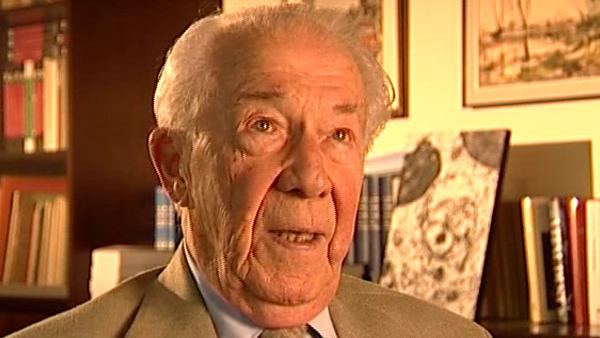NEXT STORY

Research into a new field: the origin of life
RELATED STORIES

NEXT STORY

Research into a new field: the origin of life
RELATED STORIES


|
Views | Duration | |
|---|---|---|---|
| 71. Thierry Boon's work on tumour cells | 145 | 06:11 | |
| 72. The growth of the ICP | 74 | 03:38 | |
| 73. Freedom in Research: Learning from the Rockefeller Institute | 1 | 121 | 03:35 |
| 74. The boundaries of freedom in research | 78 | 01:38 | |
| 75. Fundraising for the ICP | 60 | 02:37 | |
| 76. 'Choose your mentors well' | 196 | 04:57 | |
| 77. The Nobel Prize is a lottery | 166 | 00:43 | |
| 78. The Rockefeller Christmas Lectures | 111 | 03:23 | |
| 79. A Guided Tour of the Living Cell | 214 | 05:26 | |
| 80. Writing Blueprint for a Cell: The Nature and Origin of... | 144 | 04:15 |


After that I began having a little more free time. I was very busy with the ICP of course, but I was less busy with... with the lab work. I had some very good co-workers – Paul Lazarow, Miklós Müller and a number of others in New York. Baudhuin, Beaufay and Berthet, were in Belgium. But they all had their own groups and I didn't really have to... much to do with them except discussing, so I did not have my own group any more. So I could spend a little more time. And so after writing that first book, I decided that I would now try to condense what is essential in a cell. That book was sort of a tour of everything that you can find in a living cell, and so I decided, now, let's find out what... what are the items, what are the properties, what are the characteristics that are essential? And so this was the second book, much thinner, called Blueprint for a Cell, which was in fact more technical, perhaps, than the first one but it had biochemical diagrams – very few pictures, but mostly biochemical diagrams. So I was back on my own turf: biochemistry. But when I got to the end of that book I said, ‘Well, maybe there should be a chapter about the origin of the cell’, and it's a topic that I had been interested in before – I had read books on the subject and I knew a little about what was going on in that field, and so, in preparing that last chapter, again I did a lot of reading and learning and studying and the chapter ended up being the second half of the book, and so it turned out to be more than just a brief description of what was going on but also a discussion of what may have gone on and even some personal proposals concerning some possible mechanisms, so I had become involved in the topic – not only as somebody from the outside who was describing what was going on, but also somebody in... in the inside trying to guess what may have happened. This, of course, put me in a situation that I myself would have disapproved of, very much earlier, because when you do research, laboratory research, you can become very irritated when people come and tell you this could be like that or this could like that. Good ideas are a dime a dozen – really, what is important and what takes time and energy and effort is doing the actual experiments to test your ideas in most cases ending up with the conclusion that your idea is wrong. And so coming up with fresh ideas is something that I always found irritating in others when I was doing active research and here I was, doing the same thing. Because there were a number of really good people – Stanley Miller, Leslie Orgel, Jerry Joyce, and quite a number of others – really working very hard in the lab to try and reproduce some of the chemical reactions whereby life may have started.
Belgian biochemist Christian de Duve (1917-2013) was best known for his work on understanding and categorising subcellular organelles. He won the Nobel Prize in Physiology or Medicine in 1974 for his joint discovery of lysosomes, the subcellular organelles that digest macromolecules and deal with ingested bacteria.
Title: Writing "Blueprint for a Cell: The Nature and Origin of Life"
Listeners: Peter Newmark
Peter Newmark has recently retired as Editorial Director of BioMed Central Ltd, the Open Access journal publisher. He obtained a D. Phil. from Oxford University and was originally a research biochemist at St Bartholomew's Hospital Medical School in London, but left research to become Biology Editor and then Deputy Editor of the journal Nature. He then became Managing Director of Current Biology Ltd, where he started a series of Current Opinion journals, and was founding Editor of the journal Current Biology. Subsequently he was Editorial Director for Elsevier Science London, before joining BioMed Central Ltd.
Tags: Blueprint for a Cell, Paul Lazaro, Miklós Müller, Stanley Miller, Leslie Orgel, Jerry Joyce
Duration: 4 minutes, 15 seconds
Date story recorded: September 2005
Date story went live: 24 January 2008